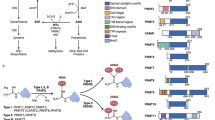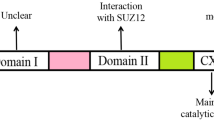Abstract
BRCA1 is closely related to the pathogenesis of breast cancer, BRCA1 mRNA is reduced in sporadic breast cancer cells despite the lack of mutations. In the present report, we find that MyoD expression and BRCA1 expression is correlated in sporadic breast tumors, overexpression of MyoD and c-myb stimulates BRCA1 expression, knockdown of MyoD and c-myb attenuates BRCA1 expression and attenuates the ability of BRCA1 to protect cells against hydrogen peroxide. MyoD and c-myb interact with p300 and PCAF, forming activating transcriptional complexes which bind to E-box and c-myb sites on the BRCA1 promoter and activate its transcription by inducing histone acetylation. Regulation of BRCA1 expression by MyoD and c-myb complexes may be part of an integral signaling pathway that determines and explains breast cancer susceptibility. Detection expression status of the various proteins in these complexes may predispose to the onset of sporadic breast cancer.







Similar content being viewed by others
Abbreviations
- E2:
-
17β-estradiol
- HAT:
-
Histone acetyltransferase
- PBS:
-
Phosphate-buffered saline
- FBS:
-
Fetal bovine serum
References
Miki Y, Swensen J, Shattuck-Eidens D, Futreal PA, Harshman K, Tavtigian S, Liu Q, Cichran C, Bennett LM, Ding W et al (1994) A strong candidate for the breast and ovarian cancer susceptibility gene BRCA1. Science 266(5182):66–71
Wilson CA, Ramos L, Villasenor MR, Anders KH, Press MF, Clarke K, Karlan B, Chen JJ, Scully R, Livingston D et al (1999) Localization of human BRCA1 and its loss in high-grade, non-inherited breast carcinomas. Nat Genet 21(2):236–240
Turner N, Tutt A, Ashworth A (2004) Hallmarks of ‘BRCAness’ in sporadic cancers. Nat Rev Cancer 4(10):814–819
Mueller CR, Roskelley CD (2003) Regulation of BRCA1 expression and its relationship to sporadic breast cancer. Breast Cancer Res 5(1):45–52
Wang A, Schneider-Broussard R, Kumar AP, MacLeod MC, Johnson DG (2000) Regulation of BRCA1 expression by the Rb-E2F pathway. J Biol Chem 275(6):4532–4536
Oberley MJ, Inman DR, Farnham PJ (2003) E2F6 negatively regulates BRCA1 in human cancer cells without methylation of histone H3 on lysine 9. J Biol Chem 278(43):42466–42476
MacLachlan TK, Dash BC, Dicker DT, El-Deiry WS (2000) Repression of BRCA1 through a feedback loop involving p53. J Biol Chem 275(41):31869–31875
Beger C, Pierce LN, Kruger M, Marcusson EG, Robbins JM, Welcsh P, Welch PJ, Welte K, King MC, Barber JR, Wong-Staal F (2001) Identification of Id4 as a regulator of BRCA1 expression by using a ribozyme-library-based inverse genomics approach. Proc Natl Acad Sci USA 98(1):130–135
Baldassarre G, Battista S, Belletti B, Thakur S, Pentimalli F, Trapasso F, Fedele M, Pierantoni G, Croce CM, Fusco A (2003) Negative regulation of BRCA1 gene expression by HMGA1 proteins accounts for the reduced BRCA1 protein levels in sporadic breast carcinoma. Mol Cell Biol 23(7):2225–2238
Rauch T, Zhong X, Pfeifer GP, Xu X (2005) 53BP1 is a positive regulator of the BRCA1 promoter. Cell Cycle 4(8):1078–1083
Jeffy BD, Hockings JK, Kemp MQ, Morgan SS, Hager JA, Beliakoff J, Whitesell LJ, Bowden GT, Romagnolo DF (2005) An estrogen receptor-A/p300 complex activates the BRCA-1 promoter at an AP-1 site that binds Jun/Fos transcription factors: repressive effects of p53 on BRCA-1 transcription. Neoplasia 7(9):873–882
Hockings JK, Degner SC, Morgan SS, Kemp MQ, Romagnolo DF (2008) Involvement of a specificity proteins-binding element in regulation of basal and estrogen-induced transcription activity of the BRCA1 gene. Breast Cancer Res 10(2):R29
Jin W, Chen L, Chen Y, Xu SG, Di GH, Yin WJ, Wu J, Shao ZM (2009) UHRF1 is associated with epigenetic silencing of BRCA1 in sporadic breast cancer. Breast Cancer Res Treat [Epub ahead of print]
Lüscher B, Eisenman RN (1990) New light on Myc and Myb. Part II. Myb. Genes Dev 4(12B):2235–2241
Introna M, Luchetti M, Castellano M, Arsura M, Golay J (1994) The myb oncogene family of transcription factors: potent regulators of hematopoietic cell proliferation and differentiation. Semin Cancer Biol 5:113–124
Drabsch Y, Hugo H, Zhang R, Dowhan DH, Miao YR, Gewirtz AM, Barry SC, Ramsay RG et al (2007) Mechanism of and requirement for estrogen-regulated MYB expression in estrogen-receptor-positive breast cancer cells. Proc Natl Acad Sci USA 104:13762–13767
Fang F, Rycyzyn MA, Clevenger CV (2009) Role of c-Myb during prolactin-induced signal transducer and activator of transcription 5a signaling in breast cancer cells. Endocrinology 150:1597–1606
Biedenkapp H, Borgmeyer U, Sippel AE, Klempnauer KH (1988) Viral myb oncogene encodes a sequence-specific DNA-binding activity. Nature 335(6193):835–837
Rønneberg JA, Tost J, Solvang HK, Alnaes GI, Johansen FE, Brendeford EM, Yakhini Z, Gut IG et al (2008) GSTP1 promoter haplotypes affect DNA methylation levels and promoter activity in breast carcinomas. Cancer Res 68:5562–5571
Yao C, Qin Z, Works KN, Austin GE, Young AN (2008) C/EBP and C-Myb sites are important for the functional activity of the human myeloperoxidase upstream enhancer. Biochem Biophys Res Commun 371(2):309–314
Wyzykowski JC, Winata TI, Mitin N, Taparowsky EJ, Konieczny SF (2002) Identification of novel MyoD gene targets in proliferating myogenic stem cells. Mol Cell Biol 22(17):6199–6208
Jin W, Chen Y, Di GH, Miron P, Hou YF, Gao H, Shao ZM (2008) Estrogen receptor (ER) beta or p53 attenuates ERalpha-mediated transcriptional activation on the BRCA2 promoter. J Biol Chem 283(44):29671–29680
Puri PL, Sartorelli V, Yang XJ, Hamamori Y, Ogryzko VV, Howard BH, Kedes L, Wang JY, Graessmann A, Nakatani Y, Levrero M (1997) Differential roles of p300 and PCAF acetyltransferases in muscle differentiation. Mol Cell 1(1):35–45
Huang J, Blackwell TK, Kedes L, Weintraub H (1996) Differences between MyoD DNA binding and activation site requirements revealed by functional random sequence selection. Mol Cell Biol 16(7):3893–3900
Bryan BA, Walshe TE, Mitchell DC, Havumaki JS, Saint-Geniez M, Maharaj AS, Maldonado AE, D’Amore PA (2008) Coordinated vascular endothelial growth factor expression and signaling during skeletal myogenic differentiation. Mol Biol Cell 19(3):994–1006
Widschwendter M, Apostolidou S, Raum E, Rothenbacher D, Fiegl H, Menon U, Stegmaier C, Jacobs IJ, Brenner H (2008) Epigenotyping in peripheral blood cell DNA and breast cancer risk: a proof of principle study. PLoS One 3(7):e2656
Xu XL, Yu J, Zhang HY, Sun MH, Gu J, Du X, Shi DR, Wang P, Yang ZH, Zhu JD (2004) Methylation profile of the promoter CpG islands of 31 genes that may contribute to colorectal carcinogenesis. World J Gastroenterol 10(23):3441–3454
Yu J, Zhang HY, Ma ZZ, Lu W, Wang YF, Zhu JD (2003) Methylation profiling of twenty four genes and the concordant methylation behaviours of nineteen genes that may contribute to hepatocellular carcinogenesis. Cell Res 13(5):319–333
Xu J, Huo D, Chen Y, Nwachukwu C, Collins C, Rowell J, Slamon DJ, Olopade OI (2009) CpG island methylation affects accessibility of the proximal BRCA1 promoter to transcription factors. Breast Cancer Res Treat 120(3):593–601
Krumm A, Madisen L, Yang XJ, Goodman R, Nakatani Y, Groudine M (1998) Long-distance transcriptional enhancement by the histone acetyltransferase PCAF. Proc Natl Acad Sci USA 95(23):13501–13506
Ogryzko VV, Schiltz RL, Russanova V, Howard BH, Nakatani Y (1996) The transcriptional coactivators p300 and CBP are histone acetyltransferases. Cell 87(5):953–959
Liu L, Scolnick DM, Trievel RC, Zhang HB, Marmorstein R, Halazonetis TD, Berger SL (1999) p53 sites acetylated in vitro by PCAF and p300 are acetylated in vivo in response to DNA damage. Mol Cell Biol 19(2):1202–1209
Vo N, Goodman RH (2001) CREB-binding protein and p300 in transcriptional regulation. J Biol Chem 276(17):13505–13508
Spillman MA, Bowcock AM (1996) BRCA1 and BRCA2 mRNA levels are coordinately elevated in human breast cancer cells in response to estrogen. Oncogene 13(8):1639–1645
Bae I, Fan S, Meng Q, Rih JK, Kim HJ, Kang HJ, Xu J, Goldberg ID, Jaiswal AK, Rosen EM (2004) BRCA1 induces antioxidant gene expression and resistance to oxidative stress. Cancer Res 64(21):7893–7909
Acknowledgments
The work was supported by the grants from Shanghai Pujiang Program (2008); Innovation Program of Shanghai Municipal Education Commission (No. 09ZZ04); the National Basic Research Program of China (2006CB910501); National Natural Science Foundation of China (30371580, 30572109); the Natural Science Foundation of Shanghai (No. 09ZR1406900); the Scientific Research Foundation for the Returned Overseas Chinese Scholars, State Education Ministry.
Author information
Authors and Affiliations
Corresponding author
Additional information
Wei Jin and Yang Liu contributed equally to the present study.
Rights and permissions
About this article
Cite this article
Jin, W., Liu, Y., Chen, L. et al. Involvement of MyoD and c-myb in regulation of basal and estrogen-induced transcription activity of the BRCA1 gene. Breast Cancer Res Treat 125, 699–713 (2011). https://doi.org/10.1007/s10549-010-0876-1
Received:
Accepted:
Published:
Issue Date:
DOI: https://doi.org/10.1007/s10549-010-0876-1




